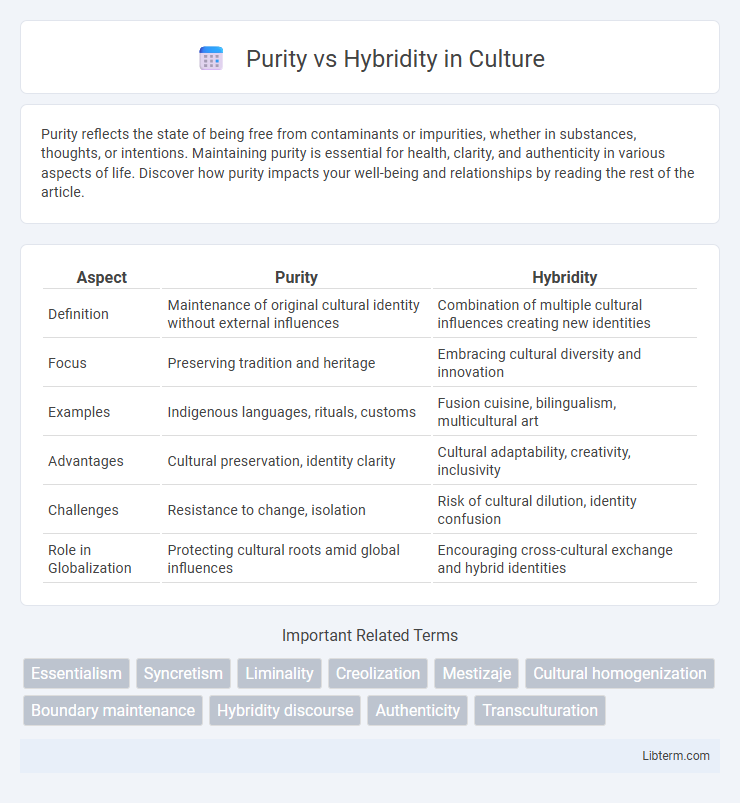Purity reflects the state of being free from contaminants or impurities, whether in substances, thoughts, or intentions. Maintaining purity is essential for health, clarity, and authenticity in various aspects of life. Discover how purity impacts your well-being and relationships by reading the rest of the article.
Table of Comparison
| Aspect | Purity | Hybridity |
|---|---|---|
| Definition | Maintenance of original cultural identity without external influences | Combination of multiple cultural influences creating new identities |
| Focus | Preserving tradition and heritage | Embracing cultural diversity and innovation |
| Examples | Indigenous languages, rituals, customs | Fusion cuisine, bilingualism, multicultural art |
| Advantages | Cultural preservation, identity clarity | Cultural adaptability, creativity, inclusivity |
| Challenges | Resistance to change, isolation | Risk of cultural dilution, identity confusion |
| Role in Globalization | Protecting cultural roots amid global influences | Encouraging cross-cultural exchange and hybrid identities |
Defining Purity and Hybridity in Contemporary Discourse
Purity in contemporary discourse often refers to the maintenance of distinct, unaltered cultural, ethnic, or ideological boundaries, emphasizing exclusivity and original authenticity. Hybridity challenges this notion by highlighting the blending and merging of identities, cultures, and practices, reflecting dynamic interactions and fluid boundaries in a globalized world. The debate between purity and hybridity frames key discussions in postcolonial studies, cultural theory, and identity politics, where the emphasis shifts from fixed categories to transformative cultural exchanges.
Historical Context: Origins of Pure and Hybrid Concepts
The concepts of purity and hybridity originated in colonial and postcolonial discourses where purity often symbolized untainted cultural or racial identities, while hybridity emerged to describe the complex blending resulting from colonial encounters. Historical contexts such as European imperialism and the transatlantic slave trade played crucial roles in shaping these ideas, framing purity as a contested ideal and hybridity as a form of resistance or adaptation. These notions were deeply intertwined with power dynamics, identity politics, and cultural negotiations across diverse societies.
Cultural Identity: Navigating Between Purity and Hybridity
Cultural identity constantly evolves as individuals and communities negotiate the tensions between purity and hybridity, blending traditional heritage with contemporary influences. This dynamic process challenges fixed notions of a singular cultural essence, emphasizing fluidity and intercultural exchange. Embracing hybridity fosters inclusivity and innovation while preserving key elements of cultural purity that anchor identity.
Language Evolution: The Dynamics of Pure and Hybrid Forms
Language evolution demonstrates the tension between purity and hybridity as pure linguistic forms strive to preserve traditional grammar and vocabulary while hybrid forms incorporate elements from multiple languages and dialects, facilitating communication and cultural exchange. Hybrid languages, such as creoles and pidgins, emerge from social contact and linguistic blending, enriching linguistic diversity and driving semantic innovation. The dynamic interplay between pure and hybrid language forms highlights ongoing adaptation to social, technological, and cultural changes, ensuring language remains a living, evolving system.
Artistic Expression: Embracing Hybridity vs. Preserving Purity
Artistic expression thrives through hybridity by blending diverse cultural influences, fostering innovation and reflecting complex identities in contemporary art forms. Preserving purity, however, emphasizes maintaining traditional techniques and cultural authenticity, safeguarding heritage against dilution in a globalized world. The dynamic tension between embracing hybridity and preserving purity enriches artistic narratives, offering both evolution and continuity in creative practices.
Globalization’s Role in Shaping Hybrid Societies
Globalization accelerates cultural exchange, leading to hybrid societies where diverse identities and traditions merge rather than remain pure or isolated. Economic integration, technological advancements, and migration create fluid cultural boundaries that challenge fixed notions of purity. Hybrid societies reflect adaptive, dynamic cultural landscapes shaped by global networks and interactions.
Purity vs Hybridity in Biological and Genetic Studies
Purity vs Hybridity in biological and genetic studies examines the contrast between genetically pure lineages and hybrid organisms resulting from the mixing of distinct gene pools. Genetic purity often emphasizes maintaining specific traits within a species or breed, while hybridity introduces genetic diversity, which can enhance adaptability and resilience. The study of hybrid vigor (heterosis) reveals how hybrids frequently exhibit superior biological qualities compared to their purebred counterparts, impacting evolutionary biology and agricultural practices.
Social Perceptions: Stereotypes and Realities
Social perceptions of purity often reinforce rigid stereotypes that marginalize hybrid identities, framing them as inauthentic or diluted. These stereotypes ignore the complex realities of cultural mixing, where hybridity fosters dynamic, multifaceted social identities that challenge essentialist notions of purity. Empirical studies highlight how hybridity enriches social cohesion and innovation, countering the simplistic binary of pure versus hybrid differences.
The Benefits and Challenges of Hybridity
Hybridity fosters cultural innovation by blending diverse traditions, creating unique identities and enhancing social adaptability. It promotes cross-cultural communication, economic opportunities, and creative expression, enriching global interconnectedness. However, hybridity also faces challenges like identity conflicts, cultural dilution, and resistance from purist groups striving to maintain traditional boundaries.
Towards a Future: Reconciling Purity and Hybridity
Reconciling purity and hybridity involves embracing cultural fluidity while respecting distinct identities, fostering inclusive societies that value diversity without erasing historical roots. Hybrid identities catalyze innovation by merging traditions and perspectives, challenging rigid purity paradigms that often marginalize minority voices. Future frameworks for cultural coexistence prioritize dynamic interaction and mutual enrichment, enabling harmonious integration of purity and hybridity concepts within globalized contexts.
Purity Infographic

 libterm.com
libterm.com